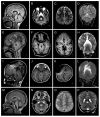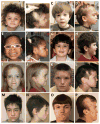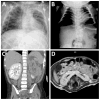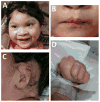Beyond Gómez-López-Hernández syndrome: recurring phenotypic themes in rhombencephalosynapsis
- PMID: 22965664
- PMCID: PMC3448816
- DOI: 10.1002/ajmg.a.35561
Beyond Gómez-López-Hernández syndrome: recurring phenotypic themes in rhombencephalosynapsis
Abstract
Rhombencephalosynapsis (RES) is an uncommon cerebellar malformation characterized by fusion of the hemispheres without an intervening vermis. Frequently described in association with Gómez-López-Hernández syndrome, RES also occurs in conjunction with VACTERL features and with holoprosencephaly (HPE). We sought to determine the full phenotypic spectrum of RES in a large cohort of patients. Information was obtained through database review, patient questionnaire, radiographic, and morphologic assessment, and statistical analysis. We assessed 53 patients. Thirty-three had alopecia, 3 had trigeminal anesthesia, 14 had VACTERL features, and 2 had HPE with aventriculy. Specific craniofacial features were seen throughout the cohort, but were more common in patients with alopecia. We noted substantial overlap between groups. We conclude that although some distinct subgroups can be delineated, the overlapping features seen in our cohort suggest an underlying spectrum of RES-associated malformations rather than a collection of discrete syndromes.
Copyright © 2012 Wiley Periodicals, Inc.
Figures






Similar articles
-
Genetic evaluation including exome sequencing of two patients with Gomez-Lopez-Hernandez syndrome: Case reports and review of the literature.Am J Med Genet A. 2020 Apr;182(4):623-627. doi: 10.1002/ajmg.a.61496. Epub 2020 Jan 31. Am J Med Genet A. 2020. PMID: 32003537 Review.
-
Rhombencephalosynapsis: a hindbrain malformation associated with incomplete separation of midbrain and forebrain, hydrocephalus and a broad spectrum of severity.Brain. 2012 May;135(Pt 5):1370-86. doi: 10.1093/brain/aws065. Epub 2012 Mar 26. Brain. 2012. PMID: 22451504 Free PMC article.
-
Clinical and molecular evaluation of 13 Brazilian patients with Gomez-López-Hernández syndrome.Am J Med Genet A. 2021 Apr;185(4):1047-1058. doi: 10.1002/ajmg.a.62059. Epub 2020 Dec 31. Am J Med Genet A. 2021. PMID: 33381921
-
[Gomez-López-Hernández-Syndrome].Rofo. 2013 Jul;185(7):662-3. doi: 10.1055/s-0033-1335027. Epub 2013 Mar 14. Rofo. 2013. PMID: 23494500 German. No abstract available.
-
Rhomboencephalosynapsis: Review of the Literature.World Neurosurg. 2022 Mar;159:48-53. doi: 10.1016/j.wneu.2021.12.062. Epub 2021 Dec 22. World Neurosurg. 2022. PMID: 34954057 Review.
Cited by
-
Midbrain and hindbrain malformations: advances in clinical diagnosis, imaging, and genetics.Lancet Neurol. 2013 Apr;12(4):381-93. doi: 10.1016/S1474-4422(13)70024-3. Epub 2013 Mar 18. Lancet Neurol. 2013. PMID: 23518331 Free PMC article. Review.
-
Rhombencephalosynapsis: Fused cerebellum, confused geneticists.Am J Med Genet C Semin Med Genet. 2018 Dec;178(4):432-439. doi: 10.1002/ajmg.c.31666. Am J Med Genet C Semin Med Genet. 2018. PMID: 30580482 Free PMC article. Review.
-
Diagnosis of rhomboencephalosynapsis by MRI in a 5-year-old child.Radiol Case Rep. 2020 May 1;15(7):867-870. doi: 10.1016/j.radcr.2020.04.015. eCollection 2020 Jul. Radiol Case Rep. 2020. PMID: 32382369 Free PMC article.
-
Infantile hydrocephalus: a review of epidemiology, classification and causes.Eur J Med Genet. 2014 Aug;57(8):359-68. doi: 10.1016/j.ejmg.2014.06.002. Epub 2014 Jun 13. Eur J Med Genet. 2014. PMID: 24932902 Free PMC article. Review.
-
MN1 C-terminal truncation syndrome is a novel neurodevelopmental and craniofacial disorder with partial rhombencephalosynapsis.Brain. 2020 Jan 1;143(1):55-68. doi: 10.1093/brain/awz379. Brain. 2020. PMID: 31834374 Free PMC article.
References
-
- Armstrong DK, Burrows D. Congenital triangular alopecia. Pediatr Dermatol. 1996;13:394–396. - PubMed
-
- Assouly P, Happle R. A hairy paradox: congenital triangular alopecia with a central hair tuft. Dermatology. 2010;221:107–109. - PubMed
-
- Aydingoz U, Cila A, Aktan G. Rhombencephalosynapsis associated with hand anomalies. Br J Radiol. 1997;70:764–766. - PubMed
-
- Bargman H. Congenital triangular alopecia. J Am Acad Dermatol. 1988;18:390. - PubMed
Publication types
MeSH terms
Supplementary concepts
Grants and funding
LinkOut - more resources
Full Text Sources
Medical

